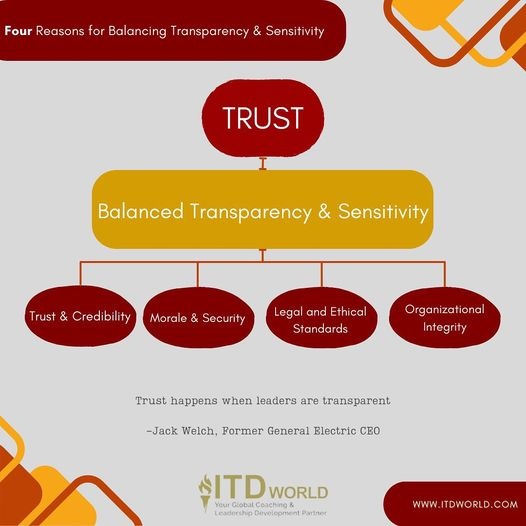In the modern business world, transparent leadership is needed for sustainable organizational success. Leaders who practice transparency drive trust, improve communication, enhance collaboration, and foster better engagement. The question, however, is how to strike the balance between transparency and sensitivity.
|
Author: Aaron Ngui |
What is Transparent Leadership?
There may be many ingredients that go into the making of transparent leadership, yet a case can be made for openness, honesty, and clear communication between leadership and their teams as the three vital ones. This involves:
- Communicating relevant information in a timely manner;
- Being frank yet respectful about challenges, verbally recognizing success, and
- Developing an environment where people feel safe to voice their thoughts and concerns.
Yet, being transparent is not being indiscriminate with information. There are many forms of information that require discretion. These could include proprietary data, personal matters, strategic plans, and security access, among others. Handling the organization’s interests and privacy needs to be dealt with care.
Maintaining an equilibrium between transparency and information sensitivity is essential so that openness does not result in confusion, insecurity, or confidentiality breaches.
Trust happens when leaders are transparent – Jack Welch, former General Electric CEO
4 Reasons for Balancing Transparency and Sensitivity
- Trust and credibility
Transparent leadership builds trust but oversharing can erode it. People need to know that leaders will share only what is important to their roles and functions without compromising confidential or strategic details.
- Employee morale and security
Sharing too much, especially during times of volatility, can lead to anxiety and decreased morale. Leaders must provide enough information to keep employees informed and engaged without causing unnecessary worry.
- Legal and ethical considerations
Certain information is protected by law or ethical standards, such as employee personal data or trade secrets. Leaders must navigate these constraints carefully to avoid legal repercussions and maintain ethical standards.
-
Organizational integrity
Maintaining the right balance ensures that the organization operates smoothly without internal conflicts or external vulnerabilities that could arise from indiscriminate transparency.

Key Strategies for Balancing Transparent Leadership and Sensitivity
Achieving a good mix of transparency and sensitivity requires intentional approaches and thoughtful communication. Here are some key approaches leaders can adopt:
-
Assess the sensitivity of the information
Before sharing anything, leaders should evaluate its potential impact. When categorizing information based on sensitivity, they can better determine what should be shared and what should remain confidential. Questions to consider include:- Is this information confidential or proprietary?
- Could sharing this harm the organization or its employees?
- Is this information necessary for employees to perform their roles effectively?
-
Determine the appropriate level of transparency
Not every single bit of information is relevant to every team member. A good approach is to take a tailored approach based on the audience and the context. For instance, while senior management might need detailed financial reports, other executives may only require high-level overviews. -
Communicate with clarity and purpose
Leaders who share information do well to keep in mind that messages are to be delivered clearly and with a specific purpose. Explain why the information is being shared and how it aligns with the organization’s goals. Such clarity helps prevent misunderstandings and ensures that the message is received as intended. -
Establish clear guidelines
Organizations are strongly encouraged to develop policies that outline what types of information can be shared and the protocols for handling sensitive data. These guidelines provide a framework for consistent and responsible transparency across the organization. -
Foster a culture of responsible transparency
Transparency is a shared responsibility. Encouraging people to practice discretion and handle sensitive information responsibly helps maintain organizational integrity. Leaders can model this behavior by being selective and thoughtful about what they share. -
Provide support during difficult conversations.
Transparency often involves sharing challenging news, such as organizational changes or financial difficulties. Approach these conversations with empathy and provide support by addressing concerns and offering resources to help team members navigate challenging situations.
I think the currency of leadership is transparency. You’ve got to be truthful, don’t think you should be vulnerable everyday, but there are moments where you’ve got to share your soul and conscience with people and show them who you are, and not be afraid of it. – Howard Schultz, former Starbucks CEO
Implementing Balanced Transparency
There are several steps organizations and leaders can take to implement balanced transparency that integrates into their daily practices:
- Establishing regular communication channels, such as town hall meetings, newsletters, and team briefings, ensures that people are consistently informed about organizational developments. These channels should be used to share pertinent information while respecting confidentiality where necessary.
- Clearly communicating the organization’s vision, mission, and strategic goals helps team members understand the bigger picture. When people are aware of the direction the organization is heading, they can align their efforts accordingly without needing to know every detailed plan. An effective approach for clear communication is to leverage the power of simplicity to ensure messages are consistent and easily understood.
- Identifying which pieces of information are essential for team members to know is another important thing to keep in mind. For example, sharing the rationale behind major decisions can help people understand and support those decisions without disclosing sensitive financial or strategic details.
- For sensitive matters, such as personal team member issues or confidential business strategies, leaders should use secure and appropriate channels. This ensures that sensitive information is handled with the necessary discretion and respect.
- Providing training on effective communication and the importance of balancing transparency with sensitivity can equip people with the skills to handle information responsibly. Education initiatives can also reinforce the organization’s guidelines and policies on transparency.
- Leveraging communication tools and platforms can enhance transparency while maintaining control over sensitive information. These include intranets, project management software, and secure messaging systems which can facilitate effective and controlled information sharing.
Challenges in Balancing Transparency and Sensitivity
- Information overload: Sharing too much information may result in team members feeling overwhelmed. This can lead to confusion and decreased productivity. Leaders must discern what can be shared to maximize productivity and effectiveness.
- Maintaining consistency: Balancing transparency and sensitivity requires ongoing effort and attention. Inconsistent application of policies can erode trust and create uncertainty.
- Handling negative information: Careful communication is needed when sharing negative news, such as financial setbacks or organizational changes to allay fears, prevent panic, and sustain morale. If the need arises to present negative information, approach the communication with empathy and provide context to help people understand and navigate the situation. Balancing negative narratives with how to address the mental health and well-being issues arising from such developments is an approach leaders can take to mitigate the situation.
- Legal & compliance issues: Leaders must navigate legal constraints related to information sharing, such as data protection laws and contractual confidentiality agreements. Ensuring compliance while maintaining transparency adds an additional layer of complexity.
- Cultural differences: In global organizations, cultural differences may influence perceptions of transparency and sensitivity. Leaders must be aware of and respect these differences to communicate effectively across cultures and diverse teams
Read more: Situational Leadership – Guide to Implementation
5 Best Practices to Overcome Challenges for Transparent Leadership
-
Develop Comprehensive Communication Policies
Establish clear policies that outline the types of information to be shared, the appropriate channels for communication, and the protocols for handling sensitive data. These policies provide a roadmap for consistent and responsible transparency. -
Open and Honest Communication
Even when sharing difficult news, maintaining honesty and openness helps preserve trust. Leaders should ensure they communicate challenges candidly while also outlining steps being taken to address them.
-
Train Leaders and Managers
Equip leaders and managers with the skills to communicate effectively, handle sensitive information, and navigate complex conversations with expert corporate training from reputable training providers. Solid training programs enable leaders to balance transparency with discretion.
-
Leverage Technology
Utilize technology solutions that allow for controlled information sharing. Tools such as secure intranets, encrypted communication platforms, and access-controlled databases can facilitate transparent communication while protecting sensitive data.
-
Foster a Culture of Mutual Respect and Responsibility
Encourage a culture where both leaders and employees respect the need for discretion and understand the importance of responsible information sharing. This mutual respect reinforces the organization’s commitment to balanced transparency.
The most important role of a leader is to set a clear direction, be transparent about how to get there and to stay the course. – Irene Rosenfeld, former Mondelēz International CEO
Moving Forward
Achieving the right mix of transparency and sensitivity in leadership is a nuanced and ongoing process. Addressing this requires thoughtful strategies and deliberate communication. Leaders who navigate this complex challenge build trust, enhance communication, and drive organizational success while safeguarding the integrity and security of their organizations.
In an era where information is a critical asset, the ability to balance transparency with sensitivity is a leadership skill and a strategic imperative. Those who embrace this balance enhance their credibility and trustworthiness – while fostering a thriving, engaged, and resilient high-performance team poised for long-term success.
Other resources you might be interested in:
- Leadership Branding: Crafting an Inspiring Personal Identity
- Leadership Self-reflection: Leading with Clarity
- Inspirational Leadership: Key Principles & Practices
- Weak Leadership: How It Undermine Success



